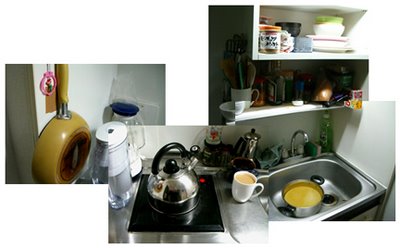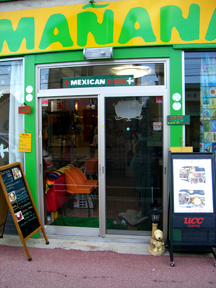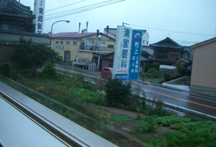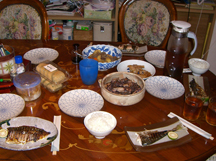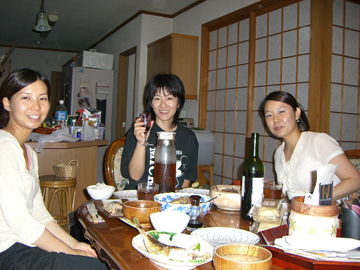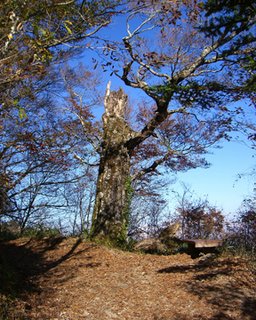
Ishizuchi-san’s Beech Forest
Ishizuchi-san is Shikoku’s highest and most famous holy mountain. Pilgrims and tourists of all sorts have been climbing it for 1300 years. I am partial to mountains, and was able to take a walk up the hill on October 30th. I left Imabari on the 6:07 am local train to Iyo-Saijo. The bus to Ishizuchi-san leaves from Iyo-Saijo, but only runs 4 times daily; I took the 7:43 to the ropeway. There is a trail that runs up the mountain starting half a km. past the ropeway, but it's steep, and might add 2.5 hours to the hike. I wasn’t sure I could catch the 3:17 return bus, so I took the ropeway. It was scenic and fast, traversing almost 3000 feet of elevation in what seemed like a few minutes. The hill was dotted with red and yellow colour; Autumn, my favorite season, was here.
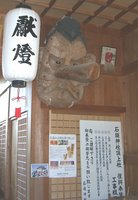
The path winds up to some refreshment shops and Jojusha, a large and impressive shrine. A wonderful mask there looks like Richard Nixon with a very long nose. Turning left through a torii, the path to Ishizuchi-san runs along a ridge through the forest. I immediately noticed the Beech trees, and found Sassafras leaves on the path. I know Sassafras only through leaves I have studied from 42 million year old Eocene fossils in Kamloops, BC. I started to look around me more carefully and soon realized that I was in a very special kind of forest with a broad range of trees, bushes and plants. The understory of Sasu, dwarf bamboo, is specific to this ecosystem, as is a rare form of aralia. I thought I saw Fir trees, some kind of Yew, and Arbutus, which I only know from a small area right around Vancouver. I saw Japanese maple, Cedar, a Birch tree and what I thought must be Alder. I found a leaf which seemed like it came from a Viburnum. I found out later that this is called Taiheiyo Montaine Deciduous Forest. It seemed a very special place, and quite beautiful. But pressing on, the hill steepened.

I came to the first set of chains, and, in a fit of machismo, climbed them. When I came to the top I walked over the little peak, and found more chains dropping eighty feet over a nasty rock face to the path. I chickened out and went back down the first set, and stayed away from the chains from then on. The trail now climbed more steeply to a second ridge, where it came out into the open, and I could see the mountains to the south and east clearly for the first time… a stunning view!

Through a second torii and up the final face, steep again, eventually coming to the peak of Mizan. Here there is a small Shinto shrine and a ryokan, at almost 6,000 feet elevation! The day was sunny, and the view spectacular. I decided to scramble over to Tengu-Dake, a ten minute hike along a razorback ridge. As I scrambled over one section of tilted rock, nothing to my left but blue sky and clouds, and nothing to my right except steeply tilted rock, blue sky and clouds, I gained a lot of respect for those who had come before me!
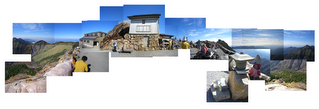
From Mizan I could see paths descending to the south, and along the mountain ridges to the east and west. On the way back down, I struck up a conversation with a man who runs a business selling watches. He likes to climb mountains and hikes to stay in shape. He told me he had come up the mountain by a different route, early that morning. I hoped to walk down the trail to the bus stop rather than take the ropeway if I had time. We were almost there when I saw a small path leading off to the right. A sign on it said Nishinokawa. He said: “your route”. I shook his hand and went down the path.
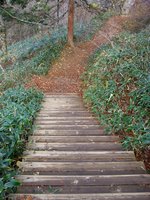
The trail was narrow and very steep. As I walked fast through the cedar plantation, I could hear repeated chanting in the valley below me. I stopped to listen to it echo faintly through the woods, and recorded it. The last kilometer of the trail was on a network of village paths, winding past three abandoned houses and eventually through a small village, mostly, it seemed, abandoned as well. This was interesting but it made me melancholy to see so much labor, so much knowledge, abandoned. I came out on the road about a half km up the valley from the ropeway. In a parking place stood about twenty five young Japanese men and women in white yukata and headbands. Two middle aged men were talking to them. Whatever the ceremony, it had ended. I headed down the road.

I missed my bus by nine minutes. Ah, well. I spent the next two hours drying off (I was soaked with sweat) as the afternoon turned chilly. The last bus arrived just after five. The bus driver was the same older gentleman who was driving in the morning. He motioned me over, and told me I could get in…In my very bad, very basic Japanese I told him I was going to Saijo, and pointed back down the road from where he’d just come. He laughed and repeated that I should get in. So I said thanks!, grabbed my pack and found a seat. He drove up the road to where the trail came out and turned the bus. We waited there ten minutes, during which time he swept around the bus shelter with a rough straw broom. Just as he was firing up our bus to leave, three busloads of the mysterious practitioners swept by, on their way home at last.
I shouldn’t have taken the trail down; I could hardly walk for the next four days.

